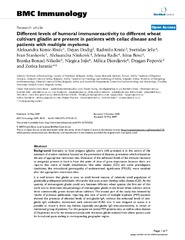| dc.creator | Konić-Ristić, Aleksandra | |
| dc.creator | Dodig, Dejan | |
| dc.creator | Krstić, Radmilo | |
| dc.creator | Jelić, Svetislav | |
| dc.creator | Stanković, Ivan | |
| dc.creator | Ninković, Aleksandra | |
| dc.creator | Radić, Jelena | |
| dc.creator | Besu, Irina | |
| dc.creator | Bonaci-Nikolić, Branka | |
| dc.creator | Jojić, Njegica | |
| dc.creator | Đorđević, Milica | |
| dc.creator | Popović, Dragan | |
| dc.creator | Juranić, Zorica | |
| dc.date.accessioned | 2019-09-02T11:17:49Z | |
| dc.date.available | 2019-09-02T11:17:49Z | |
| dc.date.issued | 2009 | |
| dc.identifier.issn | 1471-2237 | |
| dc.identifier.uri | https://farfar.pharmacy.bg.ac.rs/handle/123456789/1238 | |
| dc.description.abstract | Background: Immunity to food antigens (gliadin, cow's milk proteins) is in the centre of the attention of modern medicine focused on the prevention of diseases, prevention which is based on the use of appropriate restriction diet. Detection of the enhanced levels of the immune reactions to antigen(s) present in food is from this point of view of great importance because there are reports that some of health disturbances, like celiac disease (CD) and some premalignant conditions, like monoclonal gammopathy of undetermined significance (MGUS), were vanished after the appropriate restriction diets. It is well known that gliadin is toxic to small bowel mucosa of relatively small population of genetically predisposed individuals, who under this toxic action develop celiac disease (CD). As the quantity of immunogenic gliadin could vary between different wheat species, the first aim of this work was to determine the percentage of immunogenic gliadin in ten bread wheat cultivars and in three commercially grown durum wheat cultivars. The second part of the study was initiated by results of previous publication, reporting that sera of some of multiple myeloma (MM) patients showed the presence of elevated levels of anti-gliadin IgA, without the enhanced levels of anti-gliadin IgG antibodies, determined with commercial ELISA test. It was designed to assess is it possible to reveal is there any hidden, especially anti-gliadin IgG immunoreactivity, in serum of mentioned group of patients. For this purpose we tested MM patients sera, as well as celiac disease (CD) patients sera for the immunoreaction with the native gliadin isolated from wheat species used for bread and pasta making in corresponding geographic region. Results: Gliadin was isolated from wheat flour by two step 60% ehanolic extraction. Its content was determined by commercial R5 Mendez Elisa using PWG gliadin as the standard. Results obtained showed that immunogenic gliadin content varies between 50.4 and 65.4 mg/g in bread wheat cultivars and between 20 and 25.6 mg/g in durum wheat cultivars. Anti-gliadin IgA and IgG immunoreactivity of patients' sera in (IU/ml) was firstly determined by commercial diagnostic Binding Site ELISA test, and then additionally by non-commercial ELISA tests, using standardized ethanol wheat extracts-gliadin as the antigen. In both patients groups IgA immunoreactivity to gliadin from different cultivars was almost homogenous and in correlation with results from commercial test (except for one patient with IgA(lambda) myeloma, they were more then five times higher). But, results for IgG immunoreactivity were more frequently inhomogeneous, and especially for few MM patients, they were more then five times higher and did not correlate with results obtained using Binding Site test. Conclusion: Results obtained showed different content of immunogenic gliadin epitopes in various species of wheat. They also point for new effort to elucidate is there a need to develop new standard antigen, the representative mixture of gliadin isolated from local wheat species used for bread production in corresponding geographic region for ELISA diagnostic tests. | en |
| dc.publisher | BMC, LONDON | |
| dc.relation | info:eu-repo/grantAgreement/MESTD/MPN2006-2010/145006/RS// | |
| dc.rights | openAccess | |
| dc.source | BMC Immunology | |
| dc.title | Different levels of humoral immunoreactivity to different wheat cultivars gliadin are present in patients with celiac disease and in patients with multiple myeloma | en |
| dc.type | article | |
| dc.rights.license | ARR | |
| dcterms.abstract | Додиг, Дејан; Поповић, Драган; Јелић, Светислав; Станковић, Иван; Нинковић, Aлександра; Јуранић, Зорица; Крстић, Радмило; Радић, Јелена; Бонаци-Николић, Бранка; Јојић, Његица; Ђорђевић, Милица; Бесу, Ирина; Конић-Ристић, Aлександра; | |
| dc.citation.volume | 10 | |
| dc.citation.other | 10: - | |
| dc.citation.rank | M22 | |
| dc.identifier.wos | 000267746300001 | |
| dc.identifier.doi | 10.1186/1471-2172-10-32 | |
| dc.identifier.pmid | 19480718 | |
| dc.identifier.scopus | 2-s2.0-67649214502 | |
| dc.identifier.fulltext | https://farfar.pharmacy.bg.ac.rs//bitstream/id/186/1236.pdf | |
| dc.type.version | publishedVersion | |

